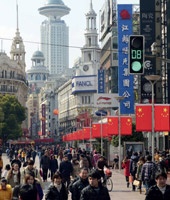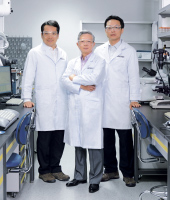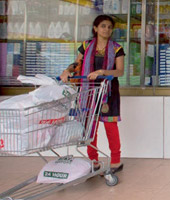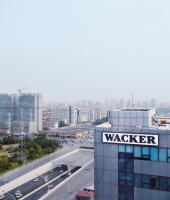Economic and Legal Factors
WACKER sells its products and services to virtually every industry. Although economic fluctuations cannot be avoided in individual business divisions, their impact and onset may vary greatly. We are, however, able to mitigate the impact of these fluctuations thanks to our product portfolio and broad customer base.
Orders
The terms for orders placed with WACKER vary from division to division. Most orders received by WACKER SILICONES are short-term, with a small number of long-term orders. Delivery is usually effected within three months of receipt of order. At WACKER POLYMERS, business is based on contracts and master agreements with terms of up to one year. Around 30 percent of incoming orders are short term. WACKER POLYSILICON’s contracts are short, medium or long term. In certain instances, they include flexible volume-specific escalator clauses. The spot market business plays only a limited role. Siltronic usually negotiates orders with the customer from one quarter to the next. As a rule, we aim for fixed contracts with negotiated prices and quantities. Due to varying order-placement procedures at the Group and its divisions, order-level reporting is not very meaningful and hence does not serve as an indicator in our monthly reports.
Operational Metrics as Leading Indicators of Future Developments
By referring to specific leading indicators based on operational metrics, we try to include potential developments in our business plans and to allocate capacities accordingly. Since our operations are based on diverse businesses and markets, we consult a number of leading indicators to gain insights into potential developments at each of our business divisions. As many of WACKER’s products are destined for the construction industry, we deploy various analytical tools in order to assess potential future growth in this segment. These tools include WACKER market research, regular customer talks, forecasts by Global Insight and Euroconstruct, and studies of our key national markets.
Leading Operational Indicators
| Download XLS |
|
|
||||
|
Business Division |
Leading Operational Indicator |
Indicator of: |
||
|
|
|
|
||
|
WACKER SILICONES WACKER POLYMERS WACKER BIOSOLUTIONS |
Raw-material and energy price trends |
Our cost trends |
||
|
WACKER SILICONES |
Orders received per month |
Our capacity utilization |
||
|
WACKER POLYSILICON |
Medium- and long-term contracts |
Our capacity utilization, |
||
|
SILTRONIC |
Data on chipmakers’ capacity utilization |
Our capacity utilization |
||
|
Every business division |
Customer talks |
Our sales trend, our product quality, market trends |
||
Economic Factors Impacting Our Business
The main economic factors influencing WACKER’s business remain unchanged in many sectors. Energy and raw-material costs, at around 40 percent of production costs, had the largest impact in 2013.
- Energy and raw-material costs
As a chemical company, we belong to an energy-intensive industry and require diverse raw materials to manufacture our products. Consequently, higher energy and raw-material costs impact our cost structure. WACKER is taking steps to become more independent of this factor. By generating our own power at Burghausen and Nünchritz, we are reducing our energy-procurement needs and thereby the cost risk. Regulatory requirements or additional expenses, such as electricity tax or levies relating to the German Renewable Energy Act (EEG), can affect WACKER’s energy costs both directly and indirectly – for example, through higher grid fees, which lead to increased operating costs for grid operators. Conversely, cost reductions in connection with the EEG levy can positively influence energy costs. Our ongoing efforts to improve our energy efficiency include the POWER PLUS program, which aims to reduce specific energy consumption by 11 percent by 2022. When procuring raw materials, we increase price flexibility by concluding new contracts with shorter terms, with more scope regarding volumes or with regular price adjustments that reflect wholesale market prices. - Exchange-rate fluctuations
The weak Japanese yen against the euro has had a negative impact on Siltronic’s business. As a rule, WACKER hedges against exchange-rate fluctuations. We use currency hedging (derivatives) to secure at least half of our dollar exposures for each subsequent year. The hedging ratio for 2013 was around 50 percent. In determining sensitivity, we simulate a 10-percent devaluation of the US dollar against the euro. Without hedging, an increase in the euro against the US dollar would have negatively impacted EBITDA by € –59 million.
- State-regulated incentive and feed-in tariff programs for renewable energy sources
As one of the world’s leading suppliers of hyperpure polycrystalline silicon, we are affected by regulatory changes to incentive and feed-in tariff programs for renewable energy sources. Due to the price decline for solar modules and cells, solar energy has greatly increased its competitive advantage over fossil fuels and other forms of energy generation. As a result, the solar market’s continued growth has become more independent of state-regulated incentive and tariff programs. At the same time, WACKER has kept its focus on improving productivity in order to maintain its competitive position. Our cost leadership, product quality, international orientation, customer structure and our medium- to long-term supplier contracts all offer us competitive advantages over other producers.
Legal Factors Impacting Our Business
In 2013, the most negative impact facing WACKER’s future operations resulted from anti-dumping proceedings instigated both by the European Union against Chinese solar companies and by the Chinese Ministry of Commerce against polysilicon manufacturers in the USA, South Korea and Europe. In late July 2013, China and the EU reached an agreement, setting a minimum price of 56 cents per watt for Chinese solar cells imported into the EU and limiting Chinese solar-panel imports into the EU to 7 gigawatts (GW) per year. The European Commission confirmed this agreement, as final, on December 6, 2013. Chinese solar cell exporters not complying with the agreed minimum prices will face punitive tariffs averaging 47.7 percent.
In January 2014 the Chinese Ministry of Commerce imposed temporary punitive tariffs on European polysilicone producers, which however have been suspended. A final decision on whether punitive tariffs will be imposed at all is still pending. WACKER rejects all forms of restraints on trade.
155 Registration Dossiers Submitted as Part of REACH
According to the EU chemicals regulation REACH (Registration, Evaluation and Authorization of Chemicals in the European Union), we are obligated to register and classify by property all substances exceeding an annual amount of one metric ton. By late 2013, WACKER had submitted 155 registration dossiers to the European Chemicals Agency (ECHA). This includes 67 registration dossiers for substances between 100 and 1,000 metric tons a year, the registration deadline of which expired on May 31, 2013. As part of the normal REACH procedure, the ECHA still requires companies to provide additional information on dossiers submitted during the first phase (2010), which we complied with in 2013. By the end of 2013, together with the EU members’ regulatory bodies, the ECHA had identified 151 substances of very high concern for people and the environment as candidates for authorization. WACKER has been only marginally affected to date, with only a few purchased substances, and none of its own. As part of the EU Commission’s GHS (Globally Harmonized System of Classification and Labeling of Chemicals), all mixtures will have been reclassified pursuant to EU-GHS (7,000 mixtures) by 2015. A central register for hazardous substances has been set up at the ECHA. We had already registered all relevant substances in 2011.
The ICCA (International Council of Chemical Associations) has developed the Global Product Strategy (GPS), which governs how to assess the properties of chemicals and how to provide information on their safe use. In Europe, most GPS requirements are satisfied by REACH and by CLP (Classification, Labeling and Packaging of Substances and Mixtures). Manufacturers are required to publish descriptions written in layman’s terms on the safe and environmentally sound use of chemicals (Safety Summaries). By the end of 2013, we had published 59 Safety Summaries on the ICC chemicals website for the substances we have registered with the European Chemicals Agency (ECHA).




